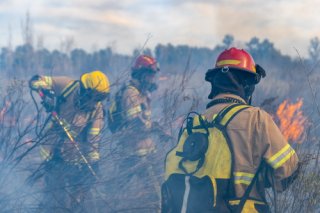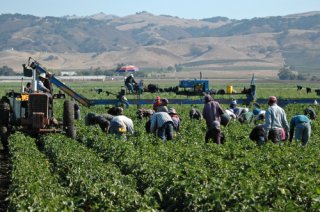Climate Change and the Health of Workers

Many workers are more vulnerable to the health impacts of climate change than the general population because:
- They work outdoors, in fields such as agriculture, construction, or transportation. This can make them more exposed to extremes in temperature and weather, poor air quality, and disease-carrying pests.1
- They work in hot indoor environments that lack adequate air conditioning, such as in manufacturing plants, warehouses, and other facilities.2
- They are emergency response workers, such as paramedics, firefighters, and police officers. These workers are more likely to be exposed to climate-related risks such as wildfire smoke or flooding from a heavy rainfall.3
Key Threats to Workers’ Health

A number of climate-related hazards threaten the health of certain groups of workers in the United States. Below are examples of the potential health impacts of these hazards.
- Heat Illnesses
- Respiratory Illnesses
- Physical and Mental Health Effects
- Insect- and Tick-Related Diseases
- Pesticide-Related Effects
Heat Illnesses
Heat illnesses can occur when a person is exposed to high temperatures and their body cannot cool down. Millions of U.S. workers are regularly exposed to heat in their workplaces.8 As the climate changes, average and extreme temperatures are increasing,9, 10 along with heat waves.11 These changes can put indoor and outdoor workers at greater risk of heat-related illnesses, such as heat stroke and exhaustion, especially in jobs that are physically demanding.
Heat-related fatigue can also impact a worker’s alertness to job-related dangers, which can increase the chance of injury or death.12 Construction, utility, transportation, and other outdoor workers face additional risks from urban heat islands, which can intensify both daytime and nighttime temperatures.13, 14
Respiratory Illnesses
Climate change will impact air quality in many ways. Some outdoor air pollutants (such as ground-level ozone and particulate matter from dust from droughts and wildfire smoke) are expected to increase.16 Outdoor workers, including agricultural and migrant workers, may be more exposed to these pollutants, which can lead to respiratory illnesses, including asthma.17, 18
As the climate changes, the increasing frequency and intensity of wildfires will lead to increased respiratory health risks for firefighters.19 For example, firefighters exposed to smoke and other wildfire combustion products can experience lung inflammation and decreased lung function.20
Earlier spring warming, precipitation changes, and rising temperatures and carbon dioxide concentrations can increase the length and severity of the pollen season.21 Data show the ragweed pollen season is already becoming longer in some U.S. locations.22 Such changes mean that outdoor workers, such as farmers, ranchers, and other agricultural workers, may face more exposure to pollen and other allergens that cause hay fever or asthma.23
Climate change can also affect indoor environments. Changes in the climate can worsen allergens and certain outdoor pollutants, which can then make their way indoors.24 Climate change can also increase the frequency and severity of some extreme weather events, including heavy rainfalls. More humidity and moisture can lead to increases in mold, bacteria, and pests, which can worsen asthma and other respiratory effects for indoor workers in damp environments.25
Certain workers may be part of other groups vulnerable to climate change. This can increase their health risks. For example, some outdoor workers may also live in communities with poor air quality.4 Older adult workers with existing health conditions can be more sensitive to extreme heat.5 Workers who are part of immigrant populations can also be more vulnerable to climate hazards since they often have fewer means to prepare and cope.6
Physical and Mental Health Effects

As the climate changes, some extreme weather events are becoming more frequent or intense.26 Floods, storms, droughts, and wildfires often require complex emergency response, recovery, and rescue operations. These operations put many types of workers at risk, including first responders, health care workers, and those involved in pre- and post-disaster support.
Workers can experience both physical and mental health effects from these events. Physical impacts can include deaths, injuries, and illnesses. Mental health effects can include anxiety, depression, and post-traumatic stress disorder.27
Insect- and Tick-Related Diseases
Warmer temperatures associated with climate change can increase mosquito development and biting rates, while increased rainfall can create more breeding sites for mosquitoes.28

Outdoor workers, such as agricultural workers, could be at higher risk of exposure to tick and insect bites that cause Lyme disease, West Nile virus, and other diseases.29 Most people who contract West Nile virus do not develop any symptoms, but in rare cases, people can experience serious illness and even die.30 Lyme disease can cause chronic pain and neurological problems if not treated early.31
Pesticide-Related Effects
Changes in pest populations and distribution are expected to increase the use of pesticides in agriculture.32 Studies show that climate change has already contributed to an expanded range for ticks.33 These changes could increase pesticide exposures for agricultural workers.34 It could also put family members in danger if workers bring pesticide residues into their homes, such as on their skin, tools, and clothing.35 Sprayed pesticides can also drift into communities and homes close to farms, increasing residents’ risk.
Both employees and employers can take steps to reduce the health impacts of climate change, including:
- Keep cool and stay hydrated. Outdoor employees should drink enough water, take breaks, and seek out shade when possible. Employers should require workers to take breaks in a cool location, and make sure that employees don’t skip these breaks.
- Plan, train, and monitor. Employers should have a written plan to prevent heat illnesses. They should also train employees to recognize heat hazards and should monitor heat-related conditions at work sites.
- Check outdoor air quality. Look at the AirNow and pollen counts on local weather reports. Pay attention to wildfire, smoke, and ash warnings.
- Improve indoor air quality. Employers of indoor workers can take steps to ensure their workplaces have adequate ventilation and moisture control.
- Take care of your mental health. Employers can ensure proper mental health services are available for their employees, especially during and after an extreme weather event or climate-related disaster.
- Prevent bites. Outdoor workers can use insect repellent and wear long-sleeved shirts and pants to prevent mosquito bites. Be aware of where ticks live. Check yourself for ticks if you have been outdoors. This is especially important during warmer months and if you have been in wooded or grassy areas.
- Protect workers who handle or come in contact with pesticides. Employers can provide training and protective equipment and take other steps to reduce pesticide exposures. Farmers may be able to reduce pesticide use through integrated pest management or other actions.
Related Resources
EPA resources:
- Outdoor Air Quality
- Indoor Air Quality
- Climate Change
- Occupational Pesticide Safety and Health
- Climate Change Science
Other resources:
Endnotes
1 Gamble, J.L., et al. (2016). Ch. 9: Populations of concern. In: The impacts of climate change on human health in the United States: A scientific assessment. U.S. Global Change Research Program, Washington, DC, p. 258.
2 Gamble, J.L., et al. (2016). Ch. 9: Populations of concern. In: The impacts of climate change on human health in the United States: A scientific assessment. U.S. Global Change Research Program, Washington, DC, p. 258.
3 Gamble, J.L., et al. (2016). Ch. 9: Populations of concern. In: The impacts of climate change on human health in the United States: A scientific assessment. U.S. Global Change Research Program, Washington, DC, p. 258.
4 Ebi, K.L., et al. (2018). Ch. 14: Human health. In: Impacts, risks, and adaptation in the United States: Fourth national climate assessment, volume II. U.S. Global Change Research Program, Washington, DC, USA, p. 547.
5 Gamble, J.L., et al. (2016). Ch. 9: Populations of concern. In: The impacts of climate change on human health in the United States: A scientific assessment. U.S. Global Change Research Program, Washington, DC, p. 257.
6 Gamble, J.L., et al. (2016). Ch. 9: Populations of concern. In: The impacts of climate change on human health in the United States: A scientific assessment. U.S. Global Change Research Program, Washington, DC, p. 252.
7 Gamble, J.L., et al. (2016). Ch. 9: Populations of concern. In: The impacts of climate change on human health in the United States: A scientific assessment. U.S. Global Change Research Program, Washington, DC, p. 259.
8 U.S. Department of Labor, Occupational Safety and Health Administration (OSHA). Working in outdoor and indoor heat environments. Retrieved 3/11/2022.
9 U.S. Environmental Protection Agency (EPA). (2021). Climate change indicators: U.S. and global temperatures. Retrieved 3/11/2022.
10 EPA. (2021). Climate change indicators: High and low temperatures. Retrieved 3/11/2022.
11 EPA. (2021). Climate change indicators: Heat waves. Retrieved 3/11/2022.
12 Gamble, J.L., et al. (2016). Ch. 9: Populations of concern. In: The impacts of climate change on human health in the United States: A scientific assessment. U.S. Global Change Research Program, Washington, DC, p. 258.
13 Sarofim, M.C., et al. (2016). Ch. 2: Temperature-related death and illness. In: The impacts of climate change on human health in the United States: A scientific assessment. U.S. Global Change Research Program, Washington, DC, p. 54.
14 Chu, E.K. et al. (2023). Ch. 12: Built Environment, Urban Systems, and Cities. Fifth National Climate Assessment. U.S. Global Change Research Program, Washington, DC, p. 12-12.
15 OSHA. Working in outdoor and indoor heat environments. Retrieved 3/11/2022.
16 Nolte, C.G., et al. (2018). Ch. 13: Air quality. In: Impacts, risks, and adaptation in the United States: Fourth national climate assessment, volume II. U.S. Global Change Research Program, Washington, DC, p. 514.
17 Gamble, J.L., et al. (2016). Ch. 9: Populations of concern. In: The impacts of climate change on human health in the United States: A scientific assessment. U.S. Global Change Research Program, Washington, DC, p. 258.
18 Nolte, C.G., et al. (2018). Ch. 13: Air quality. In: Impacts, risks, and adaptation in the United States: Fourth national climate assessment, volume II. U.S. Global Change Research Program, Washington, DC, p. 517.
19 Vose, J.M., et al. (2018). Ch. 6: Forests. In: Impacts, risks, and adaptation in the United States: Fourth national climate assessment, volume II. U.S. Global Change Research Program, Washington, DC, p. 235.
20 Bell, J.E., et al. (2016). Ch. 4: Impacts of extreme events on human health. In: The impacts of climate change on human health in the United States: A scientific assessment. U.S. Global Change Research Program, Washington, DC, pp. 110–111.
21Nolte, C.G., et al. (2018). Ch. 13: Air quality. In: Impacts, risks, and adaptation in the United States: Fourth national climate assessment, volume II. U.S. Global Change Research Program, Washington, DC, p. 526.
22 West, J.J. et al. (2023). Ch. 14: Air Quality. Fifth National Climate Assessment. U.S. Global Change Research Program, Washington, DC, pp. 14-14-15.
23 Nolte, C.G., et al. (2018). Ch. 13: Air quality. In: Impacts, risks, and adaptation in the United States: Fourth national climate assessment, volume II. U.S. Global Change Research Program, Washington, DC, p. 522.
24 Fann, N., et al. (2016). Ch. 3: Air quality impacts. In: The impacts of climate change on human health in the United States: A scientific assessment. U.S. Global Change Research Program, Washington, DC, p. 79.
25 Fann, N., et al. (2016). Ch. 3: Air quality impacts. In: The impacts of climate change on human health in the United States: A scientific assessment. U.S. Global Change Research Program, Washington, DC, pp. 82–83.
26 Intergovernmental Panel on Climate Change (IPCC). (2021). Ch. 11: Weather and climate extreme events in a changing climate. In: Climate change 2021: The physical science basis. Contribution of working group 1 to the sixth assessment report of the Intergovernmental Panel on Climate Change. Cambridge University Press.
27 Hayden, M.H. et al. (2023). Ch. 15: Human Health. Fifth National Climate Assessment. U.S. Global Change Research Program, Washington, DC, pp. 15-9, 15-10.
28 Hayden, M.H. et al. (2023). Ch. 15: Human Health. Fifth National Climate Assessment. U.S. Global Change Research Program, Washington, DC, p. 15-8.
29 Hayden, M.H. et al. (2023). Ch. 15: Human Health. Fifth National Climate Assessment. U.S. Global Change Research Program, Washington, DC, p. 15-8.
30 Centers for Disease Control and Prevention (CDC). (2024). About West Nile virus. Retrieved 7/22/2024.
31 Centers for Disease Control and Prevention (CDC). (2024). Signs and symptoms of untreated Lyme disease. Retrieved 7/22/2024.
32 Ziska, L., et al. (2016). Ch. 7: Food safety, nutrition, and distribution. In: The impacts of climate change on human health in the United States: A scientific assessment. U.S. Global Change Research Program, Washington, DC, pp. 197–198.
33 Hayden, M.H. et al. (2023). Ch. 15: Human Health. Fifth National Climate Assessment. U.S. Global Change Research Program, Washington, DC, p. 15-8
34 Ziska, L., et al. (2016). Ch. 7: Food safety, nutrition, and distribution. In: The impacts of climate change on human health in the United States: A scientific assessment. U.S. Global Change Research Program, Washington, DC, p. 200.
35 Ziska, L., et al. (2016). Ch. 7: Food safety, nutrition, and distribution. In: The impacts of climate change on human health in the United States: A scientific assessment. U.S. Global Change Research Program, Washington, DC, p. 200.
36 Beard, C.B., et al. (2016). Ch. 5: Vector-borne diseases. In: The impacts of climate change on human health in the United States: A scientific assessment. U.S. Global Change Research Program, Washington, DC, p. 142.
37 Ziska, L., et al. (2016). Ch. 7: Food safety, nutrition, and distribution. The impacts of climate change on human health in the United States: A scientific assessment. U.S. Global Change Research Program, Washington, DC, pp. 197–198.
